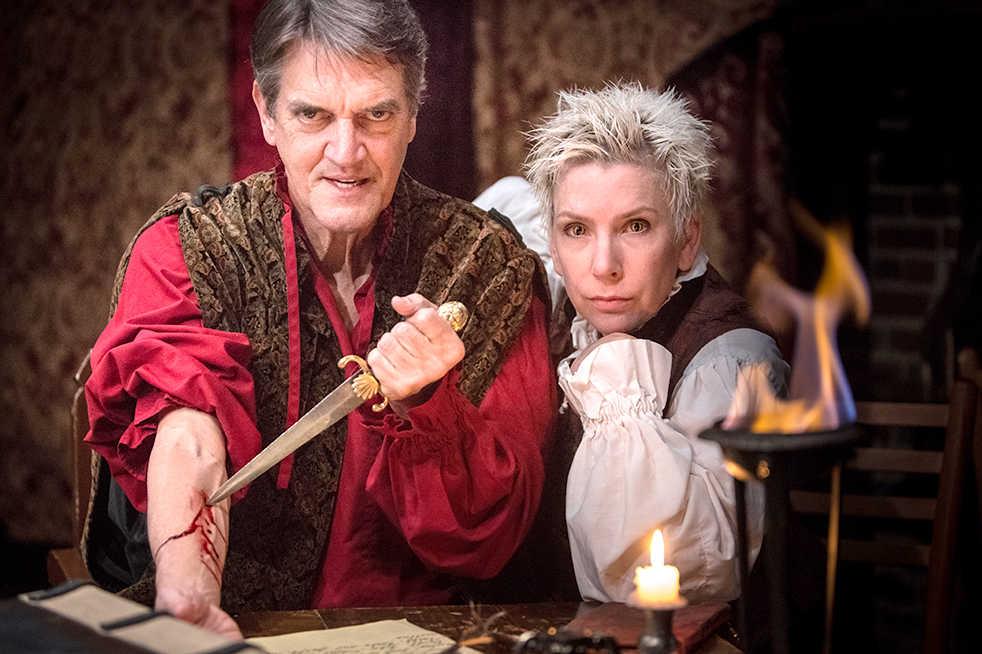Taking a break from their usual fare of Shakespearean drama, the New American Shakespeare Tavern opted for a performance written by Christopher Marlowe, one of Shakespeare’s contemporaries.
Dealings with demons and summoning Lucifer were controversial topics bordering on taboo in the late 1500s, especially for fictional and entertainment purposes, but this subject matter is precisely what “Doctor Faustus” focuses on.
Far from traditional, even the layout of the theatre indicated that this play would be unique. For other performances at the Shakespeare Tavern, and indeed, at most playhouses, the audience is seated around various tables facing a stage. The actors stay on the stage barring a few scenes requiring extravagant entrances or exits.
“Doctor Faustus,” on the other hand, occurred in the center of the room. The audience’s candlelit tables were strewn around the central clearing, and more than a few tables were even on the stage itself.
This atmosphere lent to the decidedly dark tones of the play and allowed for the play to change settings easier than if it occurred on a set stage with Dr. Faustus’ (Chris Kayser) own rooms being the central clearing and various other places in the theatre serving for his journeys.
The play itself had a more or less linear plot wherein Dr. Faustus, a renowned scholar and doctor, finds himself always searching for more knowledge. In his quest, he finds that he is capable of summoning demons, namely Mephistopheles, who is expertly played by Laura Cole.
He forsakes his Christianity and signs a contract with Lucifer: in exchange for his soul, Mephistopheles becomes his servant and is bound to do his bidding for 24 years.
At first, Dr. Faustus plans to create a better world, and he tests Mephistopheles to see if his power is complete. He quickly learns much more than anyone around and becomes a well-known magician with his own followers (also played by Laura Cole).
Throughout the play, Dr. Faustus struggles with his faith and lack thereof. He occasionally repents despite the assurance of its futility by Mephistopheles. It is quite easy to see how shocking this play would have been for its time period.
The execution of the play is far more interesting than the plot itself. Despite having many characters in the play, there are only six actors involved. Three of them are never seen, only heard as the voices of demons and of the devil himself.
The fourth actor, Anna Fontaine, plays Helen of Troy when Dr. Faustus desires to see the face that launched a thousand ships.This scene lasts for but a few seconds before the play is once again a simple affair of two actors performing admirably.
With the limited cast, or the limited visible cast, at least, it would have been simple for this rendition of “Dr. Faustus” to become an indecipherable medley of Dr. Faustus going insane, treating one person as though he were several dozen.
Fortunately for the audience, Laura Cole was more than capable of portraying her many
characters – although some were quite over the top.
Even more fortuitously, these other portrayals did not detract from her interpretation of Mephistopheles. Somehow, the demon managed to appear completely inhuman and too-human at the same time, which is perhaps one of the points of the play.
Throughout the play, several puppets made appearances in lieu of actors when demons and Lucifer needed representation. This interesting approach to all supporting characters emphasized Dr. Faustus’ internal conflict, as he had no human to turn to for help aside from the
not-quite-human Mephistopheles.
At first, the choices regarding casting – and lack thereof – sound a bit strange. While it is hard to envision a play being understandable, let alone entertaining, with such limitations it worked for “Doctor Faustus.”
To assist in this mostly two-person play, there were plenty of props. These props were far more elaborate than those normally used in the theatre’s other performances. In addition to the intricate summoning circle inscribed directly on the playhouse floor, there were tables strewn with parchment and old books. This set design provided a visualization of Dr. Faustus’s extensive learning prior to summoning demons and making deals with the devil.
“Dr. Faustus” will be performed for the rest of this weekend before the playhouse transitions into the traditional Shakespearean standby “Romeo and Juliet” for February, including Valentine’s Day. This play will provide a stark contrast to the dark performance of January.
